I created this #1 of 1 NFT image, Desperate believers, using AI generative art tool, Conjure.art. I used text from my thriller novel, Stone of Fire, combined with one of my images from a research trip to Arizona.

Thrillers, Dark Fantasy, Crime, Horror
By J.F. Penn
I created this #1 of 1 NFT image, Desperate believers, using AI generative art tool, Conjure.art. I used text from my thriller novel, Stone of Fire, combined with one of my images from a research trip to Arizona.

By J.F. Penn
I created this #1 of 1 NFT image, Names etched into history, using AI generative art tool, Conjure.art. I used a line from my thriller novel, Valley of Dry Bones, about St Louis No 1 Cemetery in New Orleans, combined with one of my images from a research trip to the city.
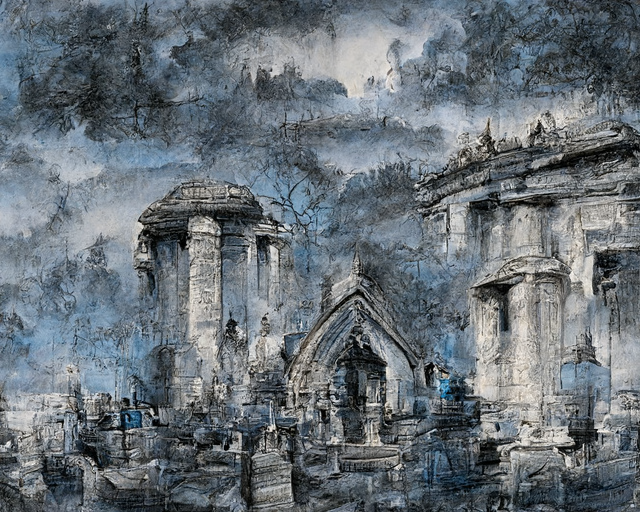
By J.F. Penn
I created this #1 of 1 NFT image, The glory of La Serenissima, using AI generative art tool, Conjure.art. I used a line from my thriller novel, Stone of Fire, about Venice combined with one of my images from a research trip to the city.
[Read more…] about The glory of La SerenissimaBy J.F. Penn
I created this #1 of 1 NFT image, Gondolas glinting in the dark water, using AI generative art tool, Conjure.art. I used a line from my thriller novel, Stone of Fire, about Venice combined with one of my images from a research trip to the city.
[Read more…] about Gondolas glinting in the dark waterBy J.F. Penn
I created this #1 of 1 NFT image, Inscribed in an ancient hand, using AI generative art tool, Conjure.art. I used a line from my thriller novel, Stone of Fire, about the Bodleian Library, Oxford, combined with one of my images of the Radcliffe Camera, where I used to study.
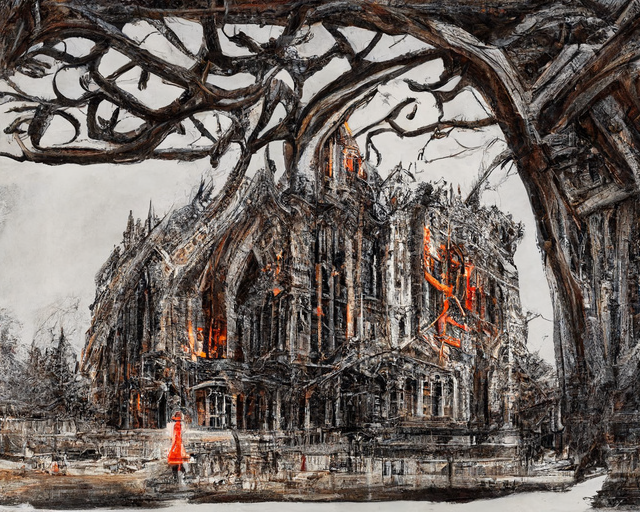
By J.F. Penn
This is my first #1 of 1 NFT, minted 11 March 2022 on Opensea. It's an image made by combining the first line of my first novel with a photo I took in Varanasi, India, in 2006 which inspired the opening scene.

By J.F. Penn
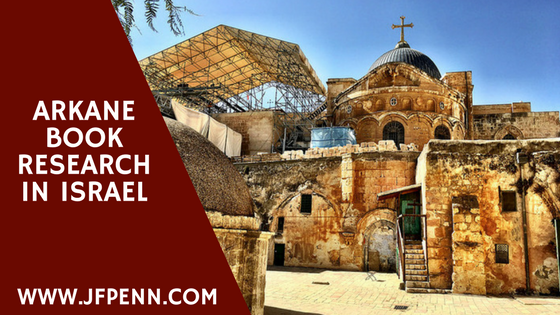
The video starts in Tel Aviv, in the old port of Jaffa, famous for Simon the Tanner's house, and the fabled port where Jonah left for Nineveh and was eaten by the whale. It was beautiful weather on the Mediterranean and I enjoyed working on the balcony in the warm!
We headed north to Galilee and visited Megiddo, the Biblical Armageddon, famous because 26 cities were built and destroyed there. A tunnel dug to a nearby cistern kept the inhabitants in fresh water when they were under siege, and the city's lives are vividly recorded in The Source by James Michener, probably the book that has influenced my writing the most.
After a quick visit to Capernaum on the Sea of Galilee, we went to the Church of Multiplication, which I loved for its translucent alabaster windows. Gorgeous!
Then on to Nazareth for the modern Church of the Annunciation, full of amazing modern art and wonderful architecture. I was thrilled to find a stained glass window of the brazen serpent on a rod [00:55] and the verse from John 3:14 in Latin, translated as “Just as Moses lifted up the snake in the wilderness, so the Son of Man must be lifted up.” I use this verse in End of Days to reference a particular stained glass window in Salisbury Cathedral, so it was fantastic synchronicity to find it here.
We crossed over to the West Bank to visit the Church of the Nativity in Bethlehem, where we visited the cave where tradition holds that Mary gave birth. The church was under (much needed) restoration for the first time in 600 years but you could seek glimpses of the mosaics under the scaffolding. That night, I enjoyed some Cotes de Bethlehem red wine …
We headed out to the desert to visit Qumran, where the Dead Sea Scrolls were found. Then up Masada, the ancient fort that eventually fell to the Romans, but not before the last remaining Jewish rebel committed suicide. Better to die than spend a life in captivity. Freedom before slavery. A place that still inspires many. You can still see the outlines of the huge Roman encampments below on the desert floor.
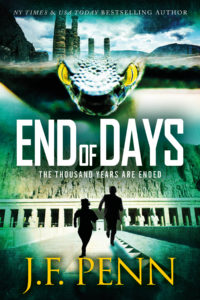
Then the starkly beautiful Negev Desert. It was an amazing trip and much of it enriches End of Days and provides a backdrop to other books in the ARKANE series.
You can see all the pictures from the Israel trip here on Flickr.
Check out End of Days, available for pre-order now and coming in ebook, print and audiobook in Jan 2017.
By J.F. Penn
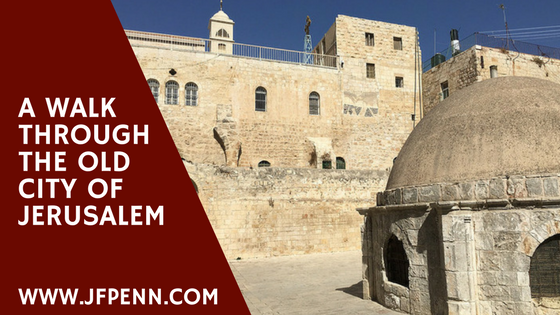
You can watch the short video below [2 min 46], or here on YouTube, and there are some trip notes below the video.
The opening picture was taken on a very windy day just before a storm arrived on the Mount of Olives, overlooking the Old City of Jerusalem. It is a popular (and very expensive) place to have a grave as Jews believe that the Messiah will arrive here at the End Times.
The video opens at the Damascus Gate and then we walk into the Arab Quarter through the souk (market). We left the street sounds in the video so you can hear the noise of the city, from Arab street vendors to the muezzin call, from text messages to the chant of Christian pilgrims and the tune of a saxophone.
You'll see Muslims and Jews in distinctive traditional clothes, as well as a group of Christians carrying a cross along the Via Dolorosa. I make some cameo appearances taking selfies in the narrow walkways 🙂
There's an Armenian pottery, a chapel at the 7th Station of the Cross, souvenir stalls in the bazaar and then we enter the Church of the Holy Sepulchre, one of the holiest places in the Christian world. Tradition holds that it was the place Jesus was crucified, then anointed and buried, and then where he rose again.
You might see some Indian pilgrims rubbing money on the Stone of Anointing, some of the chapels within the church, and then we go upstairs onto the roof of the Holy Sepulchre.
This is where the Ethiopian Coptic church have their shrine and I actually like the open simplicity far more than the cluttered chapels below. This group of monks feature in Stone of Fire as my first visit there back in the 1990s made a huge impact on me.
We went down into the 4th-century cistern of Helena, the mother of Constantine, who was responsible for turning the Roman Empire to Christianity. There are a number of cisterns under Jerusalem, but most are prohibited for use because of the security risk. I use these cisterns as a key part of the plot in End of Days. You'll see by the size of my grin on the video how thrilled I was to be able to visit one 🙂

At the Wall, there were a number of boys having their bar mitzvah. At 13, a boy is no longer considered a minor and should fulfil the commandment's of the Torah. The boy will read a passage from the Torah, carried in scrolls in the silver cases you can see. It's quite a celebration with sweets being thrown from the women's side of the wall.
You can see all the pictures from the Israel trip here on Flickr.
Check out End of Days, available for pre-order now and coming in ebook, print and audiobook in Jan 2017.